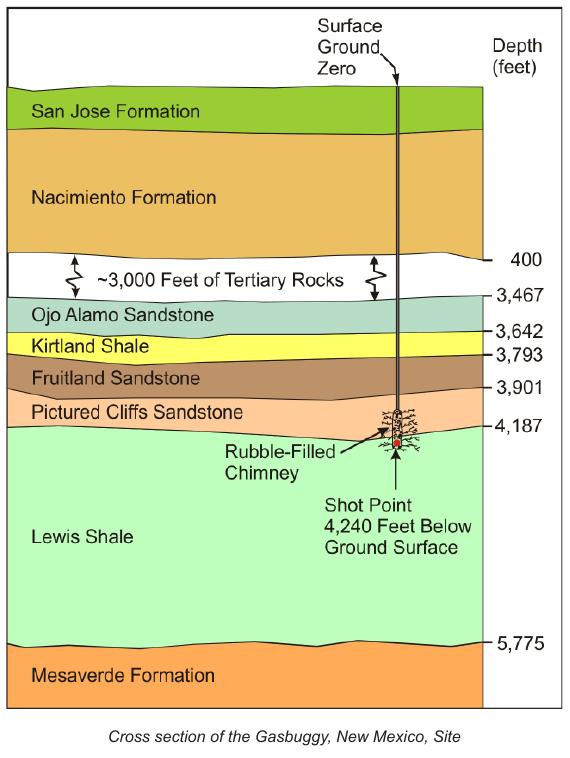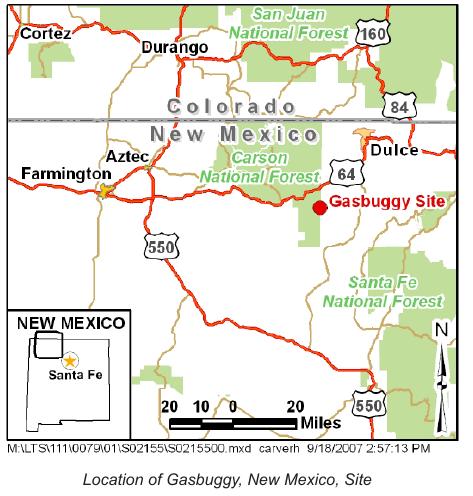The EEOICPA was passed in 2000. It provides compensation to workers who became ill as a result of their employment manufacturing nuclear weapons in the USA, as well as their spouses, children, and grandchildren. Project Gasbuggy Nuclear Explosion Site EEOICPA coverage is available for qualified former Workers and their families.
Are you eligible for compensation? If you or a family member worked at this or another DOE facility and became ill, you may be entitled to compensation of up to $400K plus medical benefits. Call EEOICPA Counsel Hugh Stephens at 1-855-548-4494 or fill out our free claim evaluation, We can help even if you’ve already filed, even if your claim was denied!
Here, we have compiled publicly available information and documentation about the facilities covered by the Act to clarify how their activities relate to the Energy Employees Occupational Illness Compensation Program Act.
Project Gasbuggy Nuclear Explosion Site
State: New Mexico
Location: Farmington
Time Period: 1967-1973; 1978 ; 1992-present (remediation)
Facility Type: Department of Energy
Facility Description: The Project Gasbuggy site was the location of one of the nuclear test explosions conducted as part of the AEC’s Plowshare program that was initiated in 1957 to develop peaceful (industrial and scientific) applications for nuclear explosives. Drilling for this operation began on February 11, 1967. On December 10, 1967, a 29 kiloton nuclear yield device was detonated in an underground shaft in natural gas and shale deposits at the Gasbuggy site. The test was conducted to determine whether nuclear explosives would stimulate the release of natural gas not recoverable by conventional methods. The operation ended in 1973 and the site was on standby until cleanup began in August 1978. A second shot scheduled for this site, named “Coach” was canceled due to the fact that the Gasbuggy shot resulted in a venting to the atmosphere.
Listing:
Project Gasbuggy Nuclear Explosion Site is listed as a Department of Energy (DOE) site under the EEOICPA.
Compensation:
As of 05/10/2015, the total compensation paid under Parts B and E of the EEOICPA, including medical compensation, for workers suffering from the effects of having worked at the Project Gasbuggy Nuclear Explosion Site is $2,040,605.
*Site Description and History:
The Gasbuggy site is located in northwestern New Mexico in Rio Arriba County, approximately 55 miles east of the city of Farmington, and 12 miles southwest of Dulce, New Mexico, in the Carson National Forest. The Gasbuggy site consists of one section of land totaling 640 acres.
On December 10, 1967, the U.S. Atomic Energy Commission (AEC), a predecessor agency of the U.S. Department of Energy (DOE), detonated a 29-kiloton-yield nuclear device 4,240 feet below ground surface in an attempt to stimulate production of natural gas from deeply buried, low-permeability, gas-bearing formations. This was the first natural-gas-reservoir stimulation experiment in the Plowshare Program, which was designed to develop peaceful uses for nuclear energy. AEC, U.S. Department of the Interior, and El Paso Natural Gas Company jointly sponsored Project Gasbuggy.
The blast created a cavity and a chimney of rubble above and within it. The purpose of the detonation was to stimulate flow of natural gas through the fractures created by the blast and use the chimney as a collection chamber. No radiation was released at the surface at the time of the blast. The molten rock in the cavity encapsulated most of the radionuclides from the detonation.
Project Gasbuggy stimulated gas production in greater quantities than in nearby conventional gas wells, but the natural gas was radioactive. Test results also indicated that the gas had a significantly lower heat value. Gas production tests and project evaluation activities were conducted from 1967 until 1976. Fracturing into the gas-bearing formation outward from the chimney (above the cavity) did not penetrate as extensively as expected.
AEC decommissioned and demobilized the site in 1978. Structures and equipment used for the test were decontaminated, if necessary, and removed; liquid radioactive waste was injected into the cavity formed by the nuclear explosion; solid radioactive waste was removed to the Nevada Test Site; and test wells were decommissioned and plugged. Soil sampling was performed in 1978, 1986, 2000, and 2002. Cultural resources, endangered and sensitive species, and floodplain and wetland surveys were performed in 1993. Final surface remediation was completed in 2004.
Surface Conditions:
Remediation of the surface resulted in the removal of 5,562 cubic yards of contaminated soil from mud pits and was completed in September 2004. No further corrective actions are required for the surface and shallow subsurface. A permanent monument consisting of a brass plaque mounted in a concrete base was placed at surface ground zero at the site. Wording on the plaque describes the historical significance of the project and restrictions on subsurface excavation.
Subsurface Conditions :
DOE does not plan to remove subsurface radioactive contamination in or around the test cavity because no feasible technology exists to do so. The DOE Office of Legacy Management (LM) will conduct monitoring to ensure that detonation-related contamination does not migrate offsite.
Land Use :
The site is located in the Carson National Forest. Prior to Project Gasbuggy, the land was open range and was used for livestock grazing and recreation. The Secretary of Agriculture, through the U.S. Forest Service, has jurisdiction over Carson National Forest. There are no surface use restrictions for the site, and the Forest Service has returned the land to its pre-Gasbuggy uses with the addition of historical markers describing the Gasbuggy test and a small parking area at surface ground zero.
Institutional Controls :
DOE controls subsurface activities to a depth of approximately 4,700 feet below ground surface, within the southwest quarter of section 36, township 29 north, range 4 west, of the New Mexico Principal Meridian. DOE’s control was obtained through a combination of a 1967 Public Land Order withdrawing the section of land where the Gasbuggy test was conducted and contractual language providing the AEC with all pre-existing oil and gas leasing rights within the 160-acre quarter section where the test was conducted. Current subsurface restrictions are stated on the monument place at the site. In summary, the inscription states no subsurface intrusion within the radius of 100 feet from surface ground zero to a true vertical depth of 1,500 feet, and no subsurface intrusion within a radius of 600 feet from surface ground zero to a true vertical depth between 1,500 feet and 4,500 feet without permission of the U.S. Government. No institutional controls are required for the surface of the Gasbuggy site. Additionally, DOE has executed an Interagency Agreement with the U.S. Forest Service and the U.S. Bureau of Land Management outlining the respective roles and responsibilities of each agency regarding notification and monitoring of natural gas and subsurface water development in the vicinity of Gasbuggy. This agreement states that DOE can conduct monitoring to assure continued protectiveness for the public and the environment.
 Long-Term Hydrologic Monitoring Program :
Long-Term Hydrologic Monitoring Program :
Starting in 1972, the U.S. Environmental Protection Agency monitored groundwater and surface water near the Gasbuggy site annually as part of the long-term hydrologic monitoring program. Samples were collected from several springs, ponds, surface water drainages, ranch wells, and livestock watering wells near the Gasbuggy site. The sampling locations were on the National Forest, Jicarilla Apache Reservation, and private property. Since 2008, LM has conducted the hydrologic monitoring. Following the annual sampling event in 2009, hydrologic monitoring has been reduced to once every 5 years since no Gasbuggy-related contamination has been detected at the monitoring locations.
Natural Gas Monitoring Program :
In 2009, DOE began monitoring natural gas, and water produced with the natural gas, at active gas wells in the vicinity of the Gasbuggy site. Contaminant transport by natural gas and water produced along with the gas is considered a more credible contaminant migration pathway than the relatively shallow groundwater and surface waters that have been historically monitored. To date no evidence of Gasbuggy-related contamination has been detected at the active gas wells being sampled.
*Source
Project Gasbuggy Nuclear Explosion Site Workers:
If you or your parent worked at this or any other DOE or AWE facility and became ill, you may be entitled to compensation of up to $400K plus medical benefits from the US Department of Labor. Call EEOICPA Counsel Hugh Stephens at 1-855-EEOICPA (336-4272) or fill out the form to the right, whether or not you have already filed a claim and even if your claim has been accepted or denied.
We can help with all OWCP (Federal Workers Compensation) claims, impairments, wage loss and health care. 2495 Main Street, Suite 442, Buffalo, NY 14214.


















